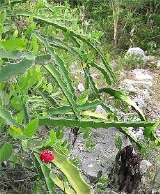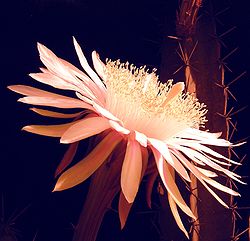
Acanthocereus tetragonus
Encyclopedia
Acanthocereus tetragonus is a species of cactus
that is native to southern Florida
and the Lower Rio Grande Valley
of Texas
in the United States
, Mexico
, Central America
, Caribbean
, and northern South America
. Common names include Night-blooming Cereus, Barbed-wire Cactus, Sword Pear, Dildo Cactus, Triangle Cactus, and Órgano-alado de Pitaya (Spanish
). It was originally described by Carl Linnaeus in 1753 as Cactus tetragonus but was moved to the genus Acanthocereus
in 1938 by Pieter Wagenaar Hummelinck.
s are grey and separated by 2 centimetre. Central areoles have one to two spines up to 4 cm (1.6 in) long, while radial areoles have six to eight spines up to 2.5 cm (0.984251968503937 in) in length. The flower
s are 14–20 cm (5.5–7.9 in) in diameter with a tube 8–15 cm (3.1–5.9 in) in length. Outer tepal
s are greenish-white, inner tepals are pure white, and pistils are creamy white. Flowers are open from midnight until dawn, attracting hummingbird moths (Hemaris
spp.). The shiny, red fruit
s are around 5 cm (2 in) long.

either cooked or raw, while the fruit
s are edible and sweet. It is sometimes cultivated as an ornamental
. The Fairy Castle Cactus, a miniature cultivar
of this species, has many curved branch
es that resemble the turret
s of a castle
.
Cactus
A cactus is a member of the plant family Cactaceae. Their distinctive appearance is a result of adaptations to conserve water in dry and/or hot environments. In most species, the stem has evolved to become photosynthetic and succulent, while the leaves have evolved into spines...
that is native to southern Florida
Florida
Florida is a state in the southeastern United States, located on the nation's Atlantic and Gulf coasts. It is bordered to the west by the Gulf of Mexico, to the north by Alabama and Georgia and to the east by the Atlantic Ocean. With a population of 18,801,310 as measured by the 2010 census, it...
and the Lower Rio Grande Valley
Rio Grande Valley
The Rio Grande Valley or the Lower Rio Grande Valley, informally called The Valley, is an area located in the southernmost tip of South Texas...
of Texas
Texas
Texas is the second largest U.S. state by both area and population, and the largest state by area in the contiguous United States.The name, based on the Caddo word "Tejas" meaning "friends" or "allies", was applied by the Spanish to the Caddo themselves and to the region of their settlement in...
in the United States
United States
The United States of America is a federal constitutional republic comprising fifty states and a federal district...
, Mexico
Mexico
The United Mexican States , commonly known as Mexico , is a federal constitutional republic in North America. It is bordered on the north by the United States; on the south and west by the Pacific Ocean; on the southeast by Guatemala, Belize, and the Caribbean Sea; and on the east by the Gulf of...
, Central America
Central America
Central America is the central geographic region of the Americas. It is the southernmost, isthmian portion of the North American continent, which connects with South America on the southeast. When considered part of the unified continental model, it is considered a subcontinent...
, Caribbean
Caribbean
The Caribbean is a crescent-shaped group of islands more than 2,000 miles long separating the Gulf of Mexico and the Caribbean Sea, to the west and south, from the Atlantic Ocean, to the east and north...
, and northern South America
South America
South America is a continent situated in the Western Hemisphere, mostly in the Southern Hemisphere, with a relatively small portion in the Northern Hemisphere. The continent is also considered a subcontinent of the Americas. It is bordered on the west by the Pacific Ocean and on the north and east...
. Common names include Night-blooming Cereus, Barbed-wire Cactus, Sword Pear, Dildo Cactus, Triangle Cactus, and Órgano-alado de Pitaya (Spanish
Spanish language
Spanish , also known as Castilian , is a Romance language in the Ibero-Romance group that evolved from several languages and dialects in central-northern Iberia around the 9th century and gradually spread with the expansion of the Kingdom of Castile into central and southern Iberia during the...
). It was originally described by Carl Linnaeus in 1753 as Cactus tetragonus but was moved to the genus Acanthocereus
Acanthocereus
Acanthocereus is a genus of cacti. Its species take the form of shrubs with arching or climbing stems up to several meters in height. The generic name is derived from the Greek word άκανθα , meaning spine, and the Latin word cereus, meaning candle.The six species occur in the tropical Americas...
in 1938 by Pieter Wagenaar Hummelinck.
Description
A. tetragonus is a tall, columnar cactus that reaches a height of 2–7 m (6.6–23 ft). Stems are dark green, have three to five angles, and are 6–8 cm (2.4–3.1 in) in diameter. AreoleAreole
Areoles are an important diagnostic feature of cacti, and identify them as a family distinct from other succulent plants. The areoles on cacti are clearly visible; they generally appear as small light- to dark-colored bumps, out of which grow clusters of spines...
s are grey and separated by 2 centimetre. Central areoles have one to two spines up to 4 cm (1.6 in) long, while radial areoles have six to eight spines up to 2.5 cm (0.984251968503937 in) in length. The flower
Flower
A flower, sometimes known as a bloom or blossom, is the reproductive structure found in flowering plants . The biological function of a flower is to effect reproduction, usually by providing a mechanism for the union of sperm with eggs...
s are 14–20 cm (5.5–7.9 in) in diameter with a tube 8–15 cm (3.1–5.9 in) in length. Outer tepal
Tepal
Tepals are elements of the perianth, or outer part of a flower, which include the petals or sepals. The term tepal is more often applied specifically when all segments of the perianth are of similar shape and color, or undifferentiated, which is called perigone...
s are greenish-white, inner tepals are pure white, and pistils are creamy white. Flowers are open from midnight until dawn, attracting hummingbird moths (Hemaris
Hemaris
Hemaris is a Holarctic genus of sphinx moths, consisting of about 17 species living in the Holarctic, four of which fly in North and South America, three fly in Europe. Their main host plants are herbs and shrubs of the Dipsacaceae and Caprifoliaceae families...
spp.). The shiny, red fruit
Fruit
In broad terms, a fruit is a structure of a plant that contains its seeds.The term has different meanings dependent on context. In non-technical usage, such as food preparation, fruit normally means the fleshy seed-associated structures of certain plants that are sweet and edible in the raw state,...
s are around 5 cm (2 in) long.

Uses
Young stems of the Barbed-wire Cactus can be eaten as a vegetableVegetable
The noun vegetable usually means an edible plant or part of a plant other than a sweet fruit or seed. This typically means the leaf, stem, or root of a plant....
either cooked or raw, while the fruit
Fruit
In broad terms, a fruit is a structure of a plant that contains its seeds.The term has different meanings dependent on context. In non-technical usage, such as food preparation, fruit normally means the fleshy seed-associated structures of certain plants that are sweet and edible in the raw state,...
s are edible and sweet. It is sometimes cultivated as an ornamental
Ornamental plant
Ornamental plants are plants that are grown for decorative purposes in gardens and landscape design projects, as house plants, for cut flowers and specimen display...
. The Fairy Castle Cactus, a miniature cultivar
Cultivar
A cultivar'Cultivar has two meanings as explained under Formal definition. When used in reference to a taxon, the word does not apply to an individual plant but to all those plants sharing the unique characteristics that define the cultivar. is a plant or group of plants selected for desirable...
of this species, has many curved branch
Branch
A branch or tree branch is a woody structural member connected to but not part of the central trunk of a tree...
es that resemble the turret
Turret
In architecture, a turret is a small tower that projects vertically from the wall of a building such as a medieval castle. Turrets were used to provide a projecting defensive position allowing covering fire to the adjacent wall in the days of military fortification...
s of a castle
Castle
A castle is a type of fortified structure built in Europe and the Middle East during the Middle Ages by European nobility. Scholars debate the scope of the word castle, but usually consider it to be the private fortified residence of a lord or noble...
.

